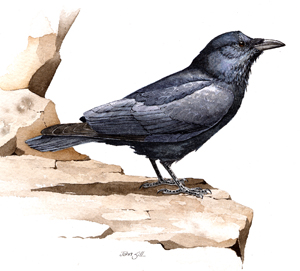Breeding Bird Atlases (BBA)
Find a Bird
Common Raven
Corvus corax

Somewhat local and strongly increasing

“Quoth the raven, ‘Nevermore.’” – Edgar Allen Poe, “The Raven”
Both reviled and revered by cultures from Scandinavia and the British Isles to the Pacific Northwest, Common Ravens are large, glossy black birds with heavy bills and a keen intellect. Despite their intelligence and usefulness as agents of carrion disposal, their association with death and ill omens made them targets for persecution by early European settlers in Massachusetts. Ever adaptable, Common Ravens can be found on several continents across a wide range of habitats, but until relatively recently it seemed that they might “nevermore” return to breed in the Bay State.
Historic Status
In writing his New England's Prospect in 1634, William Wood felt it important to compile a list of birds—in poetry form, no less—that might entice future settlers and investors to visit the New World. On that list he included “The long-liv'd Raven” as a common sight. “But the bird soon became known as a killer of sickly sheep and new-born lambs,” wrote Edward Howe Forbush, and referencing another seventeenth century work said, “and the settlers raged an endless warfare upon it, so that eventually it disappeared as a breeding bird from southern New England” (Forbush 1927). Single sightings of “accidental visitants” occurred from 1859 forward, and one site on Ragged Mountain in Adams earned the name “Raven Rocks” because of the alleged presence of nesting ravens there (Faxon 1889). Regardless, ravens remained extremely rare in Massachusetts for the next century as human persecution on the species practically everywhere gradually took its toll.
Atlas 1 Distribution
Whatever their historical status, Common Ravens were never Confirmed breeding in Massachusetts between 1974 and 1979. However, their summertime presence in the Bay State left room for conjecture. The ravens that did appear in Massachusetts during Atlas 1 were invariably seen in high areas, with mountain cliffs and quarry ledges as the preferred venues. Accordingly, all of the Possible and Probable ravens from Atlas 1 were reported either from the Taconic Mountains or the Berkshire Highlands, where they might conceivably have derived from the populations of ravens from farther north or west.
Atlas 2 Distribution and Change
Displaying the typical corvid spirit of adaptability and opportunism, Common Ravens eventually seized their chance to return to a Massachusetts where they would be (mostly) free from human persecution. By the time of Atlas 2, Common Ravens could be found from the Berkshires to Plymouth County, though the bulk of their distribution remained in the highlands of the western parts of the state. The Berkshire Highlands experienced especially pronounced growth, with ravens occupying more than 70% of the region, though Common Raven distribution expanded markedly in all of the western ecoregions. The Worcester Plateau also showed tremendous expansion, going from completely raven-less to having breeding evidence in almost 75% of the region. Ravens were also Confirmed to be breeding, often at several different sites, in every eastern region save Cape Cod and the Islands. In all likelihood, it is only a matter of time before they colonize that region as well.
Atlas 1 Map

Atlas 2 Map

Atlas Change Map

Ecoregion Data
Atlas 1 | Atlas 2 | Change | ||||||
Ecoregion | # Blocks | % Blocks | % of Range | # Blocks | % Blocks | % of Range | Change in # Blocks | Change in % Blocks |
Taconic Mountains | 1 | 6.3 | 20.0 | 13 | 52.0 | 4.0 | 10 | 66.7 |
Marble Valleys/Housatonic Valley | 0 | 0.0 | 0.0 | 23 | 59.0 | 7.0 | 23 | 59.0 |
Berkshire Highlands | 4 | 7.3 | 80.0 | 43 | 78.2 | 13.1 | 37 | 69.8 |
Lower Berkshire Hills | 0 | 0.0 | 0.0 | 18 | 58.1 | 5.5 | 18 | 66.7 |
Vermont Piedmont | 0 | 0.0 | 0.0 | 13 | 76.5 | 4.0 | 9 | 75.0 |
Berkshire Transition | 0 | 0.0 | 0.0 | 26 | 65.0 | 8.0 | 23 | 74.2 |
Connecticut River Valley | 0 | 0.0 | 0.0 | 17 | 26.2 | 5.2 | 14 | 29.2 |
Worcester Plateau | 0 | 0.0 | 0.0 | 65 | 73.9 | 19.9 | 34 | 70.8 |
Lower Worcester Plateau | 0 | 0.0 | 0.0 | 36 | 45.0 | 11.0 | 24 | 44.4 |
S. New England Coastal Plains and Hills | 0 | 0.0 | 0.0 | 61 | 21.6 | 18.7 | 47 | 20.8 |
Boston Basin | 0 | 0.0 | 0.0 | 4 | 7.1 | 1.2 | 4 | 7.3 |
Bristol and Narragansett Lowlands | 0 | 0.0 | 0.0 | 8 | 7.0 | 2.4 | 8 | 7.9 |
Cape Cod and Islands | 0 | 0.0 | 0.0 | 0 | 0.0 | 0.0 | 0 | 0.0 |
Statewide Total | 5 | 0.5 | 100.0 | 327 | 31.5 | 100.0 | 251 | 30.3 |
Notes
The Common Raven shows a significant increasing Breeding Bird Survey trend in the Eastern US overall.



